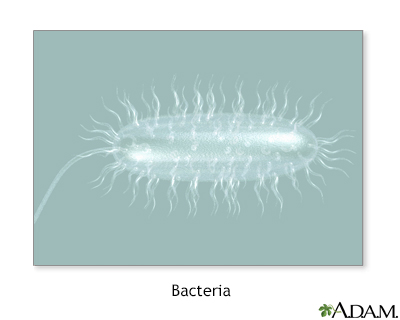Pregnancy SmartSiteTM
Infant botulism DefinitionBotulism is a rare but serious illness caused by Clostridium botulinum bacteria. The bacteria may enter the body through wounds or by eating improperly canned or preserved food. CausesClostridium botulinum are found in soil and untreated water throughout the world. The bacteria produce protective spores to help them survive. In certain conditions, such as improperly preserved or canned food, these spores can grow and produce a toxin. When eaten, even tiny amounts of this toxin can lead to severe poisoning. Foods that can be contaminated include:
Infant botulism occurs when a baby eats Clostridium botulinum spores and the bacteria grow in the baby's intestines. The most common cause of infant botulism is eating honey or corn syrup or using pacifiers that have been coated with honey. Clostridium botulinum can be found normally in the stool of some infants. Infants develop botulism when the bacteria grow in their gut. Botulism may also occur if the bacteria enter open wounds and produce toxins there. About 110 cases of botulism are reported in the United States each year. Most of the cases are in infants. SymptomsSymptoms often appear 8 to 36 hours after you eat food contaminated with the toxin. There is no fever with this infection. In adults, symptoms may include:
Symptoms in infants may include:
Exams and TestsYour health care provider will perform a physical exam. The exam may find:
Blood tests can be done to identify the toxin. A stool culture may also be ordered. Lab tests can be done on the suspected food to confirm botulism. TreatmentYou will need medicine to fight the toxin produced by the bacteria. The medicine is called botulism antitoxin. You will have to stay in the hospital if you have breathing trouble. A tube may be inserted through the nose or mouth into the windpipe to provide an airway for oxygen. You may need a breathing machine. People who have trouble swallowing may be given fluids through a vein (by IV). A feeding tube may be inserted. Providers must tell state health authorities or the Centers for Disease Control and Prevention about people with botulism, so that the contaminated food is removed from stores. Some people are given antibiotics, but they may not always help. Outlook (Prognosis)Prompt treatment greatly reduces the risk for death. Possible ComplicationsHealth problems that may result from botulism include:
When to Contact a Medical ProfessionalGo to the emergency room or call 911 or the local emergency number if you suspect botulism. PreventionNEVER give honey or corn syrup to infants younger than 1 year old. Never give even just a little taste on a pacifier. Help prevent infant botulism by breastfeeding only, if possible. Always throw away bulging cans or foul-smelling preserved foods. Sterilize home-canned foods by pressure cooking them at 250°F (121°C) for 30 minutes. This can reduce the risk for botulism. See the Centers for Disease Control and Prevention website for more information on home canning safety at www.cdc.gov/botulism/prevention/home-canned-foods.html. Keep foil-wrapped baked potatoes hot or in the refrigerator. Do not store at room temperature. Carrot juice and oils with garlic or other herbs should also be refrigerated. Make sure to set the refrigerator temperature at 40°F (10°C) or lower. ReferencesBirch TB, Bleck TP. Botulism (Clostridium botulinum). In: Bennett JE, Dolin R, Blaser MJ, eds. Mandell, Douglas, and Bennett's Principles and Practice of Infectious Diseases. 9th ed. Philadelphia, PA: Elsevier; 2020:chap 245. Norton LE, Schleiss MR. Botulism (Clostridium botulinum). In: Kliegman RM, St. Geme JW, Blum NJ, Shah SS, Tasker RC, Wilson KM, eds. Nelson Textbook of Pediatrics. 21st ed. Philadelphia, PA: Elsevier; 2020:chap 237. | ||
| ||
Review Date: 8/26/2023 Reviewed By: Jatin M. Vyas, MD, PhD, Roy and Diana Vagelos Professor in Medicine, Columbia University Vagelos College of Physicians and Surgeons, Division of Infectious Diseases, Department of Medicine, New York, NY. Also reviewed by David C. Dugdale, MD, Medical Director, Brenda Conaway, Editorial Director, and the A.D.A.M. Editorial team. View References The information provided herein should not be used during any medical emergency or for the diagnosis or treatment of any medical condition. A licensed medical professional should be consulted for diagnosis and treatment of any and all medical conditions. Links to other sites are provided for information only -- they do not constitute endorsements of those other sites. No warranty of any kind, either expressed or implied, is made as to the accuracy, reliability, timeliness, or correctness of any translations made by a third-party service of the information provided herein into any other language. © 1997- A.D.A.M., a business unit of Ebix, Inc. Any duplication or distribution of the information contained herein is strictly prohibited. | ||


 Bacteria
Bacteria
